Het menselijk ras
Urantia Boek Papers 62-80 Condensed en Illustrated
© Saskia Praamsma (1999, 2018)
1. The Andonites: 1,000,000 BC
2. The Six Sangik Races: 500,000 BC
3. The Nodites: 200,000 BC
4. The Adamites: 35,000 BC
5. The Andites: 15,000 BC
1. De Andonieten: 1.000.000 BC
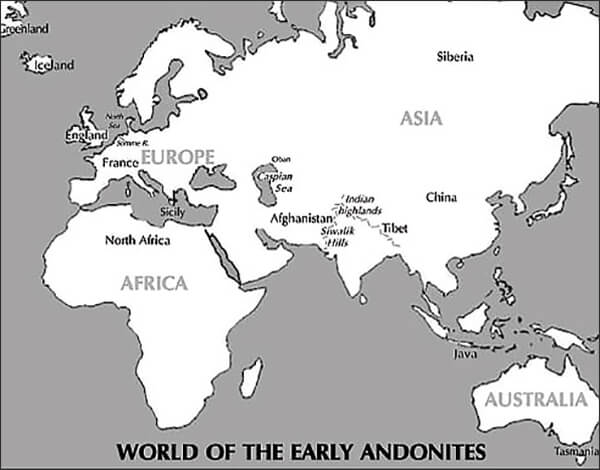
ASIA is the homeland of the human race. On a southern peninsula of this continent, in the highlands of what is now Afghanistan, the first human beings, Andon and Fonta, were born of primate parents almost a million years ago. The mutant twins were superior anatomically to their parents, but what distinguished them—what made them human—was their potential for being self-conscious will creatures who could recognize the Creator and choose to do his will. Andon and Fonta were vaguely aware that they were more than mere animals due to their possession of personality and the presence of a fragment of God within their minds.
To prevent the possibility of admixture, they conspired to move away from their animal relatives and fled north, to the highlands of India. Andon and Fonta had nineteen children. Their clans grew, and for twenty generations the Andonites stayed close to their homeland, developing a language and establishing the rudiments of human culture, until tribal conflicts and irritations, as well as competition for food, forced them to disperse. This was during the ice age, and while some groups remained behind, others migrated to the north and to the west into what is now Europe. Along the rivers and waterways leading to the North Sea they established more than one thousand separate settlements, and for tens of thousands of years they dwelt along the Somme River in France.
In those days England was connected to the continent, and the earliest Andonites living in that region were the Foxhall peoples. They were established farthest west and succeeded in retaining much of the original Andonic culture. In later times these same Andonites built boats and sailed to Iceland and Greenland, and later still to the arctic regions of North America. They have survived as the present-day Eskimos. In general physical appearance primitive man resembled the Eskimo more than any other living human type.
Whenever the Andonites drifted down into the warmer southern climes they tended to mate with their subhuman cousins. In later years many of their mongrel descendants returned to England from southern France to breed with the expanding Andonic tribes. While the absorption of inferior animal strains retarded the progress of the European Andonites, they were somewhat invigorated by a biologically superior group who followed them and spread out over Europe, the Heidelberg race.
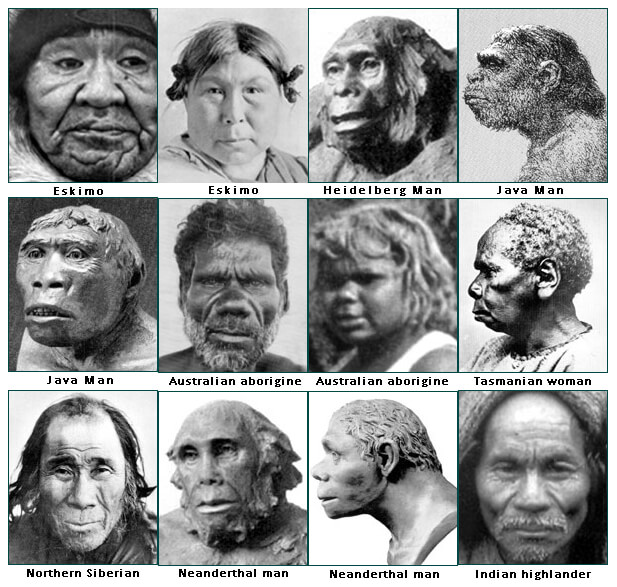
At times there was a continuous land path from England to Java, and later on down as far as Tasmania. The groups going west were not as contaminated with debased animal strains as those going east, who mingled so freely with their retarded cousins. Culturally and spiritually, the most advanced of the early Andonic tribes existed in the region of the present Caspian Sea at a settlement called Oban. Under the leadership of Onagar, these tribes had developed doctrines of one Deity, and sent out the world's first missionaries to the distant settlements.
The best genetic stock persevered in the foothills of the northwestern Indian highlands among the Badonan tribes; Badonan was a great-great-grandson of Andon. Nearby, in Tibet and in the Siwalik Hills of northern India, lingered some of the animalistic stock of common ancestral origin. About 850,000 years ago the superior Badonan tribes began a campaign to exterminate these inferior groups, and in less than a thousand years most of these strains had been either destroyed or driven away. The mixed descendants of these warring tribes are known as the Neanderthal race. The Neanderthalers gradually spread from their centers in India to France on the west, China on the east, and down into northern Africa. They dominated the world for almost half a million years.
1. The Andonites: 1000000 BC
2. The six Sangik races: 500 000 BC
3. The Nodites: 200 000 BC
4. The Adamites: 35,000 BC
5. The Andites: 15,000 BC
2. The Six Sangik races: 500 000 BC
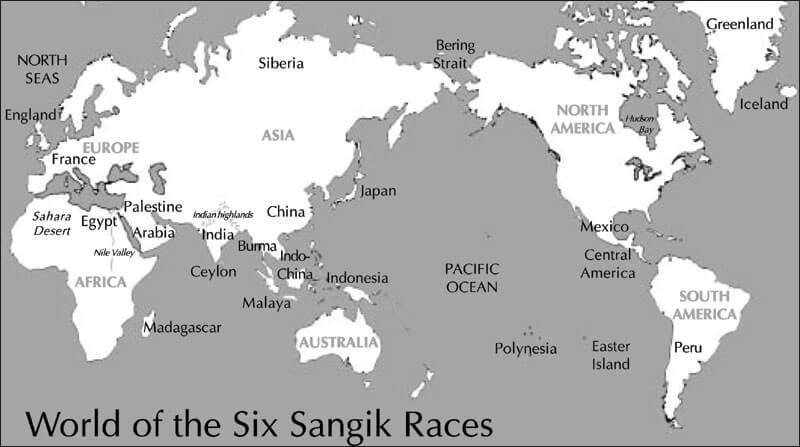
FIVE HUNDRED THOUSAND YEARS AGO the Badonan tribes of India, superior descendants of the original Andonites, became involved in another great racial struggle. Warfare raged for over a hundred years and in the end one hundred families, representing the most desirable strains of all the living descendants of Andon and Fonta, remained. Among them a man and a woman began suddenly to produce a family of remarkable mutant children, nineteen in number, who were not only more intelligent than their fellows but whose skins had a tendency to turn various colors when exposed to sunlight. There were five red, two orange, four yellow, two green, four blue, and two indigo. This was the Sangik family, the ancestors of the six colored races.
For almost 100,000 years these Sangik peoples mingled together and spread out around the foothills of the northwestern Indian highlands, until population expansion forced them to migrate. The primary Sangiks—red, yellow, and blue—sought the colder north, while the secondary Sangiks—orange, green, and indigo—preferred the warmer south.
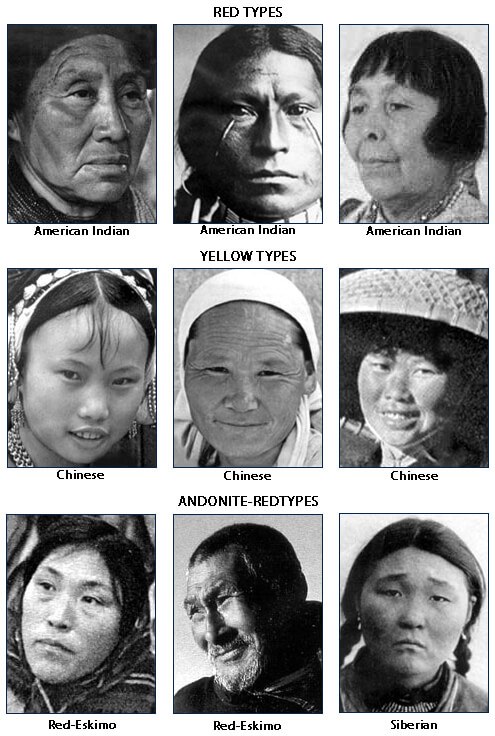
RED
The red man was the first to leave his central Asian home, going in a northeasterly direction to occupy Asia. The Neanderthalers, spread out over the entire breadth of Eurasia and whose eastern wing was the most contaminated by debased strains, had recently been driven south by the advancing ice, and by the time the red man arrived the land was relatively free of these subhuman types. For almost 100,000 years the red man reigned supreme in eastern Asia, until his yellow brethren came to displace him.
YELLOW
Three hundred thousand years ago the main body of the yellow race entered China from the south as coastwise migrants. Destroying or driving off the mainland any lingering animalistic Neanderthal strains as he went along, slowly the yellow man penetrated farther and farther inland until he began to encroach on the red man´s territory. For over two hundred thousand years these two superior races struggled for control of Asia until the red man, defeated and with his back against the ice, was driven into North America across the newly passable Bering land bridge.
RED, ESKIMO
It was 85,000 years ago when the last of the comparatively pure remnants of the red race, numbering around seven thousand men, women and children, crossed en masse to North America. Shortly thereafter they became isolated when the Bering land isthmus sank. The red man never returned to Asia, but he left behind his genetic imprint in Siberia, northern China, central Asia, India, and Europe.
Five thousand years after the red man arrived in America, the freezing over of the north seas compelled the Eskimos in Greenland to continue moving in a westerly direction, reaching the continent of North America not long after the red man had arrived in Alaska. Five thousand years ago a chance meeting occurred between an Indian tribe and a lone Eskimo group on the southeastern shores of Hudson Bay. They intermarried, and as a result these Eskimos were eventually absorbed by the more numerous red men. This encounter represents the isolated red man's sole contact with the rest of the world until comparatively recent times.
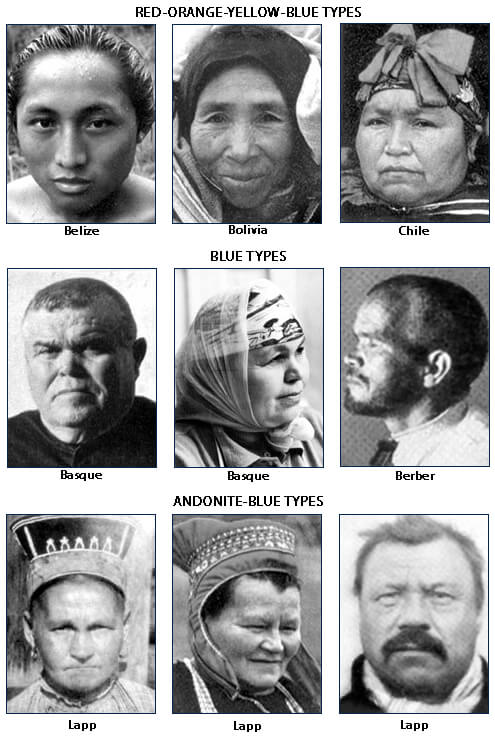
RED, YELLOW, ORANGE, BLUE
Accompanying the red race across the Bering Strait were three small groups of mixed ancestry, mainly orange and blue. They early separated from the red man and continued down into Mexico and Central America, where they were later joined by a small group of mixed yellows and reds. These races amalgamated, and within five thousand years divided into three groups, establishing the civilizations respectively of Mexico, Central America, and South America. (Their later and more enduring civilizations were founded by a race predominantly red but containing a considerable admixture of yellow, orange, and blue.)
BLUE
On the European continent the ice was beginning to retreat, allowing the blue man, together with a few other small racial groups, to migrate westward from their Indian highland home. Following the old Andonite trails, they invaded Europe in successive waves. (The Basques and the Berbers, though admixed with Saharans and others, represent two surviving strains of this race.) In Europe they encountered their Neanderthal brethren, who had been driven south and east by the glacier. The mingling of the blue man with the Neanderthal peoples led to the immediate improvement of the older race. Lapps and the Eskimos are blends of Andonite and Sangik-blue races. During the following interglacial period this new blue-Neanderthal race extended from England to India.

ORANGE
Around 300,000 BC the orange race turned west from their homeland and began to move southward along the coast towards Africa. They established their headquarters at Armageddon, in Palestine, but made little impression before being destroyed by the later arriving green man.
GREEN
Near their center of race origin the green race split into three major divisions: The northern tribes were assimilated by the yellow and blue races; the eastern branch amalgamated with the Indian peoples of those days, and remnants still persist among them; the southern group entered Africa, where they encountered and annihilated their orange cousins. The orange man, as a race, ceased to exist 100,000 years ago; his genetic remains were absorbed by the green victors and by the soon-to-follow indigo men.
INDIGO
The indigos were the last of the Sangik peoples to migrate from their birthplace. About the time of the green/orange racial wars in Egypt, the great black exodus began to wend its way south along the coast toward Africa. Soon the indigo man entered Egypt where he overpowered the green man by sheer force of numbers. These indigo races absorbed the remnants of the orange man and much of the stock of the green man, and this amalgamation proved beneficial to certain of the indigo tribes. The indigo race moved south into the forests of Africa, and has been the dominant racial group on the continent ever since.
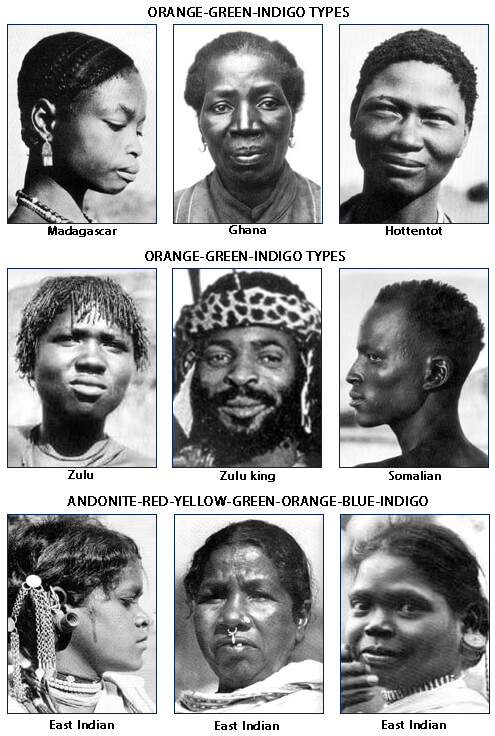
ANDONITE, RED, YELLOW, GREEN, ORANGE, BLUE, INDIGO
In India, the earliest race mixtures were a blend of the migrating red and yellow races with the aboriginal Andonites. This combined group later absorbed the greater portion of the extinct eastern green peoples as well as large numbers of the orange race, had limited admixture with the blue man, and assimilated a heavy percentage of the indigo race. The aborigines of India are not these peoples but are rather the most ancient southern and eastern fringe.
In India and China the secondary Sangiks gravitated to the south, where their cultures intermingled in Burma and the peninsula of Indo-China. Here the vanished green race has persisted in larger proportion than anywhere else.
GREEN, INDIGO, RED, YELLOW
As these darker peoples continued to drift further south, they spilled over onto the islands. Many different races have occupied the islands of the Pacific Ocean.
The southern and then more extensive islands were first inhabited by peoples carrying a heavy percentage of green and indigo blood; the northern islands were held by Andonites and, later on, by races embracing large proportions of yellow and red. The early red and yellow men had mingled to a degree in Asia, and their offspring—the present-day brown men—followed the southeastern seacoast until they were pushed onto the peninsulas and nearby islands. The ancestors of the Japanese people were driven off the mainland around 12,000 BC by the northern Chinese tribes.
1. The Andonites: 1000000 BC
2. The six Sangik races: 500 000 BC
3. The Nodites: 200,000 BC
4.The Adamites: 35,000 BC
5. The Andites: 15,000 BC
3. Nodieten: 200.000 BC
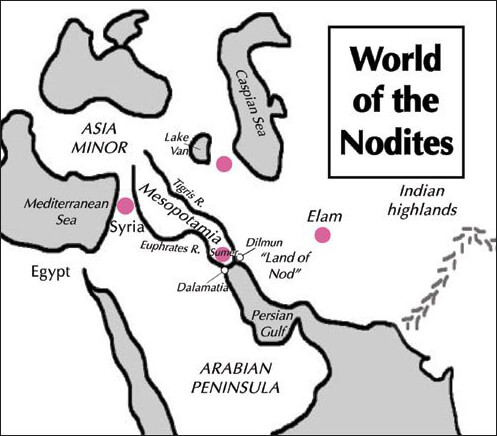
THE PRINCE’S STAFF
Concurrent with the appearance of the six Sangik races, the unseen Planetary Prince Caligastia and his supermaterial staff of volunteers arrived on Urantia to teach and minister to the almost one-half billion primitive human beings who were on earth at that time. The Prince´s headquarters, Dalamatia, was established at about the center of world population, in the Persian Gulf region of those days.
The one hundred staff members were ascendant morontia citizens of Jerusem, the headquarters of our local system of inhabited planets. These beings had already lived and died on other worlds, and as descendant planetary missionaries on Urantia they were to have visible flesh-and-blood bodies. Permission had been granted to transplant Andonic DNA into the life forms projected for the staff´s use while on their mission. Fifty males and fifty females, chosen by the Life Carriers as representing the best surviving Andonite strains, were guided from various points on the planet to Dalamatia where the living material was extracted then transferred into the staff’s preconstructed bodies.
THE PRIMARY MIDWAYERS
With their new bodies the Caligastia 100 were now capable of procreating material offspring, but were instructed not to engage in sexual reproduction. They did, however, explore every phase of mind and soul liaison, and this experiment brought into being the first of the primary midwayers. This new creature was visible to the superhuman staff and their celestial associates but not to the human tribes. As these midway creatures are known on other worlds to be invaluable liaisons between the material and the angelic realms, the entire staff was authorized to produce similar beings, and, following the instructions of the pioneer pair, all were successful. Fifty thousand primary midway creatures were thus brought forth.
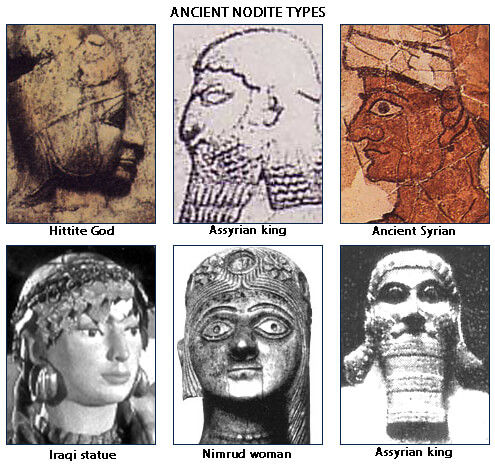
200,000 BC: THE NODITES
When their work was cut short by the Lucifer Rebellion, the staff members who went astray chose Nod as their leader. Because the Caligastia 100 carried the Andonite gene package, one would expect that, if they engaged in sexual reproduction, their progeny would resemble other Andonite offspring. But when the 60 rebel staff members elected to procreate physical beings as their successors, their children were far superior to the Andonites and the Sangiks—physically, intellectually, and with regard to spiritual capacities. These mutant traits resulted from the presence in their bodies of powerful Jerusem life-maintenance circuits which caused the Urantia chromosomes to reorganize more after the local universe patterns (similar to how X-rays alter the DNA of plants and animals).
The one hundred Andonite germ plasm contributors had in turn been modified so that the same life currents invested their bodies, and when they mated among themselves they too produced superior offspring. The progeny of these two groups constitutes the ancestry of the Nodites, the eighth race to appear on Urantia.


The near-destruction of Dalamatia by the surrounding semi-savage tribes and the city’s subsequent submergence under a tidal wave forced the Nodites to move north and east where they founded the new city of Dilmun; their dwelling place was known as "the land of Nod." The Nodites multiplied, and when some of their descendants began to spill over into the adjoining lands and intermarry with the Andonic and Sangik tribes, the purer Nodites attempted to build a tower to symbolize their racial unity. Conflict and confusion led to the dispersion of the Nodites, who eventually divided into four great groups:
The western (Syrian) Nodites journeyed west and settled in the region of Syria where they united with the Andonites. They contributed much to the later appearing Assyrian stock.
The eastern (Elamite) Nodites migrated eastward into Elam (Persia, Iran) and mated with the mixed Sangik tribes. Becoming largely Sangik in nature, they continued to maintain a civilization superior to that of the surrounding barbarians.
The central (pre-Sumerian) Nodites were a small group who remained for thousands of years at the mouth of the Tigris and Euphrates rivers. They eventually furnished the Nodite ancestry which blended with the Adamites to found the Sumerian peoples of historic times.
The northern Nodites and Amadonites—the Vanites, a fourth group, also arose. Those Andonites who had remained loyal were led by Van and Amadon, and were known as the Amadonites. They represented the best of the Andonic culture. Their followers early withdrew to the same highlands west of India where the Badonan tribes had once been exempt from hostile attacks, and they also established centers in the Lake Van/Caspian Sea area. Here they were joined by some of the descendants of the rebel Dalamations, and together these two groups were known as the Vanites. They continued to furnish leadership for the world until the arrival of Adam and Eve.
1. The Andonites: 1,000,000 BC
2. The six Sangik races: 500,000 BC
3. The Nodites: 200,000 BC
4. The Adamites: 35.000 BC
5. The Andites: 15.000 BC
4. Adamieten: 35.000 BC
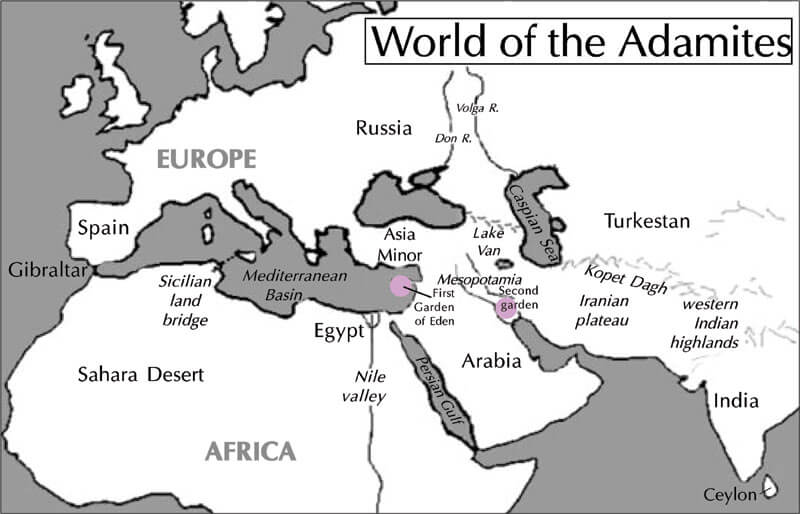
35,000 BC: THE ADAMITES
Adam and Eve were the founders of the violet race, the ninth human race to appear on Urantia. They were imported from Jerusem, sent to our planet as teachers, ministers, and biologic uplifters for the evolutionary races. Regardless of its lagging cultural evolution, the human race had exhausted its biological potentials and was ready for an infusion of new qualities.
Adam and Eve were around eight feet tall, had blue eyes, light hair color—yellow, red, and brown—and fair complexions that emanated a violet glow. Their progeny was designed to interbreed with the human stock, and these sons and daughters were prepared to endow humanity with new characteristics—a heightened sense of humor, augmented artistic and musical abilities, imagination, love of adventure, curiosity, higher intelligence, and enhanced spiritual receptivity. The ordained plan was to build up a large reserve of pure-line Adamites before mating with selected members of the human race.
The first Garden of Eden was located on a now-sunken peninsula off the eastern shore of the Mediterranean Sea, and here Adam and Eve served to educate and inspire the races for over a hundred years before defaulting in their mission. Reduced to mortal status and driven out of the garden, the Adamites were forced to find another location in which to carry on their work. At this point their family consisted of four generations numbering 1,647 pure-line descendants (most of whom chose to leave the planet after the default) plus two offspring of joint parentage with the mortal stock.
After becoming established in the second garden between the Tigris and Euphrates rivers in Mesopotamia, Adam and Eve had forty-two more children. Adam also elected to impregnate women selected by Eve from the highest strains of the Nodites and the surrounding tribes, and the world was thus given an additional 1,570 exceptional men and women, the biologic foundation for the later-appearing mighty Andite race.
AROUND 35,000 BC; THE ADAMSONITES
Adamson, the eldest son of Adam and Eve, had often heard about the Nodite/Vanite settlements in the north, and sometime after the establishment of the second garden he determined to go in search of this land. (Adamson was then 120 years old and had fathered thirty-two pure-line children, all of whom, along with his mate, had elected to return to Jerusem after the default.) A company of twenty-seven followed Adamson northward. Here, in one of the easternmost of the old Vanite colonies, he discovered a beautiful young woman named Ratta who claimed to be the last pure-line descendant of the Prince's staff. Adamson and Ratta were soon married, and their family of sixty-seven children gave origin to a great line of the world's leadership. The Adamsonites, whose headquarters was in the region east of the southern end of the Caspian Sea near the Kopet Dagh, maintained a high civilization for almost seven thousand years from the time of Adamson and Ratta. Four diverse cultures successively arose there, fostered by four different groups of Adamson´s descendants.
THE SECONDARY MIDWAYERS
While both Adamson and Ratta were capable of producing human offspring, they were really superhuman. To their surprise, every fourth child born to them was often invisible. When the second unusual creature arrived, and since one was male and the other female, Adamson decided to mate them. The progeny of these beings constitute the secondary order of midway creatures. Within one hundred years almost two thousand were brought into being. The sixteen original children lived and died as mortals of the realm, but their electrically energized offspring live on and on, not being subject to the limitations of mortal flesh. They, together with their primary midwayer cousins, represent the permanent citizens of our planet.
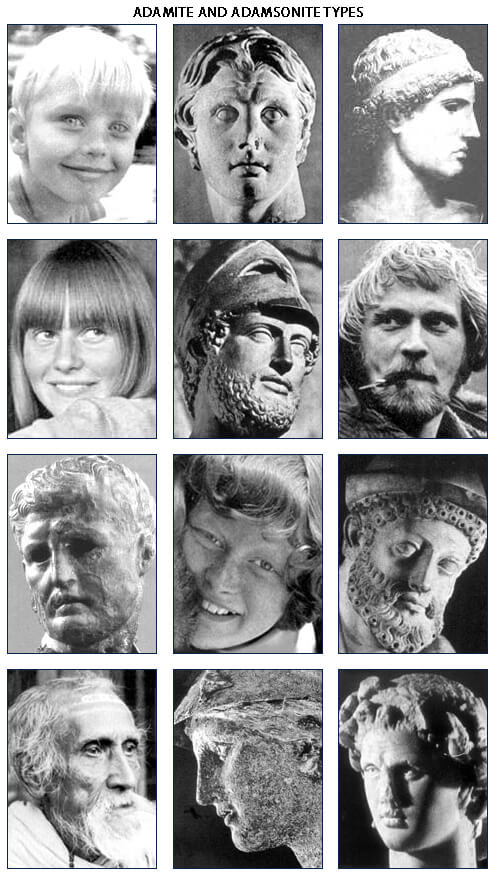
25,000-15,000 BC: THE ADAMIC MIGRATIONS
For 30,000 years the cradle of civilization was in Mesopotamia where the peaceful violet race established its second center of culture and religion. It had long been the custom for "the sons of God" to mate with "the daughters of man," to find wives in the nearby "land of Nod," the land of the nearby Nodites. About 25,000 years ago, when population pressures forced them to expand, the Adamites began sending forth their excess inhabitants to the surrounding lands as teachers, traders, and explorers.
EGYPT: Long before Adam arrived, the blue men of Europe and the mixed races of Arabia had driven the purer indigo man out of Egypt and far south on the African continent, but there were still pockets of the indigo race carrying extensive strains of the submerged orange and green races who had their better-developed settlements in what is now the Sahara desert. When the Adamites first began to penetrate Egypt, the Sicilian land bridge connected Europe to Africa, protecting the Mediterranean basin. Here Adamites met and mingled with European blue men from the north, Saharans from the south, and broad-headed Syrian Nodites from the east.
Egypt had received a very limited amount of Adamic blood before severe drought conditions in the Sahara forced its population of smaller-statured, dark-eyed, long-headed brunets to disperse. While the purer indigo elements continued their southward drift into central Africa, the mixed groups spread out in three directions: The more advanced tribes went west across northern Africa to Spain and adjacent parts of Europe, forming the nucleus of the later Mediterranean races; the least progressive division migrated to Arabia and thence through northern Mesopotamia and India to faraway Ceylon; and the central group headed north and east to the Nile valley and into Palestine.
Not long afterward the isthmus of Gibraltar gave way as the result of an earthquake, creating one sea of the Mediterranean and raising it to the level of the Atlantic Ocean. This cataclysm disrupted the culture of the Mediterranean basin, and the westward-moving Adamites were forced to retreat. The great influx of Saharans on their heels drove them to the north and east of Mesopotamia, to the highland regions northwest of India, where they quickly assimilated the best of the Andonic cultures that had been preserved. Moving slowly, by 23,000 BC they reached Turkestan where, encountering mountain barriers and the then-expanded Caspian Sea, they settled down for many generations to hunt, herd, and till the soil. Here they became thoroughly admixed with the Nodites, Andonites, and red and yellow Sangiks. Gradually these blended Adamites extended their territory from Turkestan into southern Russia, and as they rounded into Europe, they encountered the blue man whose culture, though dominant, was far behind that of Mesopotamia.
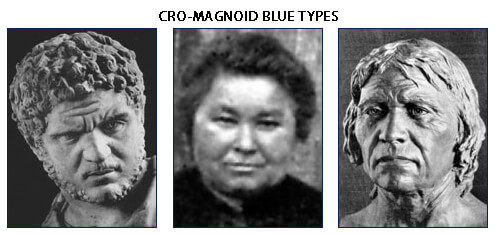
The blue men were scattered all over Europe, and while Neanderthal absorption had greatly retarded their progress, their better centers were situated in the then fertile valleys of the Mediterranean basin and in northwestern Europe. The pre-Adamic European blue races were already a highly blended people carrying strains of both red and yellow, while on the Atlantic coast lands and in the regions of present-day Russia they had absorbed a considerable amount of Andonite blood. Slowly these Adamites united with the best of the blue man while ruthlessly exterminating the lingering strains of Neanderthal stock. A dozen or more progressive groups were thus produced, one of which has come to be known as the Cro-Magnon man. With Adamic infusion the Cro-Magnoid blue man commenced to establish settlements and engage in agriculture and commerce; he also began to save many of the mediocre captives as slaves whose descendants subsequently weakened the Cro-Magnon type.
By 19,000 BC the Adamites of the second garden were a real nation, numbering four and a half million, and had poured forth millions of their progeny into the surrounding lands.
1. The Andonites: 1,000,000 BC
2. The six Sangik races: 500,000 BC
3. The Nodites: 200,000 BC
4. The Adamites: 35.000 BC
5. The Andites: 15.000 BC
5. Andieten: 15.000 BC

BY 15,000 BC the Adamites in the second garden had become so blended with the other races, particularly the Nodites, that they could no longer be considered Adamites. This new racial mix—which later would incorporate some of the better strains of the yellow, blue, and green men—combined to form a new race called the Andites. These early Andites were pre-Aryan and pre-white, neither an Occidental nor an Oriental race.
15,000-8000 BC: THE EARLY ANDITE MIGRATIONS
AFRICA: From Mesopotamia the Andites continued to permeate the Mediterranean regions, contributing much to the northern groups of the Saharan Sangik peoples, but rarely did they venture farther down into Africa than the headwaters of the Nile. Later on, mixed Andites and Egyptians followed both coasts down to well below the equator, but they did not reach Madagascar.
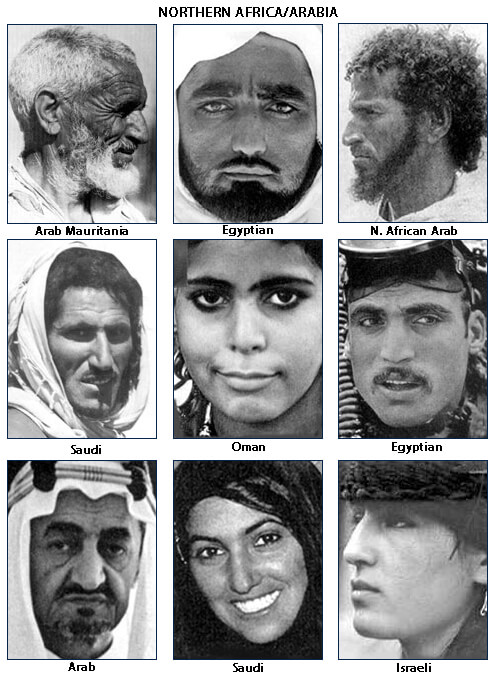
GREECE: Around 12,000 BC a brilliant tribe of Andites migrated to Crete. These were the narrow-headed, smaller-statured Andites who had intermarried with the Vanite division of the northern Nodites. All were under six feet tall and had been driven off the mainland by their larger fellows. Two thousand years later a group of 375 Adamsonites left their highland home near the Caspian Sea and crossed by way of the northern islands to Greece. This group, the progenitors of the Greeks, were of a high intellectual order and, physically regarded, the most beautiful of men since the days of the first Eden.
TURKESTAN/EUROPE: While some Andites entered Europe via the islands of the Aegean, the majority came by way of the Caspian Sea/Turkestan route. The highlands of Turkestan had experienced a constant replenishing of the Adamite stock, and now this land became the homeland of the Turkestan Andites. Here the Aryan/Indo-European mother tongue—a combination of the regional Andonic dialect and the language of the Adamsonites and later Andites—was in the process of formation. These Andites poured into Europe in a steady stream, in seven major invasions. The earlier, purer Adamic migrations had been peaceful, but the mixed Andites were aggressive, and in the later invasions they made military conquests.
INDIA/SE ASIA: The same population pressures that drove the Turkestan Andites into Europe also brought about the first extensive Andite movement toward India. For over fifteen centuries these Andites, together with their Iranian Andite brethren whom they collected en route, streamed into India through the highlands of Baluchistan. Their presence in central Asia greatly upstepped the ancestors of the Turanians. From this region they moved into the Punjab, then spread out over the river valleys and southward into the Deccan. This Andite pressure from the northwest drove much of the darker southern and eastern population fringe into Burma [Myanmar] and southern China. By 10,000 BC, the Andites in India had become submerged, the resultant mix called Dravidian. The Dravidian civilization has survived into modern times in the Deccan.
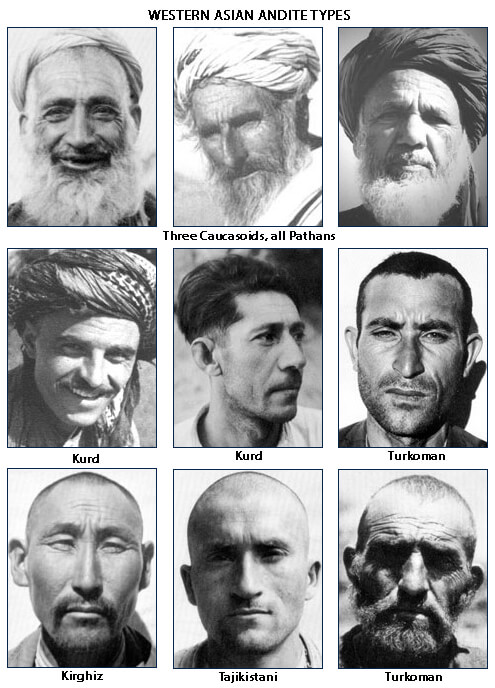
CHINA: In China the earliest advanced yellow settlements were in Tibet and along the Yellow and Yangtze rivers. For almost fifteen thousand years the easternmost Andite communities were located in the Tarim Valley in Sinkiang [Xinjiang], where Andites entered into trade relations with the progressive Chinese to the east and with the Andonites to the north. By 13,000 BC Chinese culture was being boosted by a steady inpouring of blended Andites and Andonites carrying Andite blood eastward from Sinkiang and Tibet to the upper valley of the Yellow River. Presently they reached Honan [Henan], where the leading settlements were situated, and by 10,000 BC the northern Chinese people had begun to build cities and engage in manufacture.
From time to time small groups of Andites entered southern China, coming from the north. This genetic infusion was beneficial, as the southern Chinese had absorbed much of the green race and had been infiltrated by masses of darker peoples crowded out of India by the Dravidian-Andite invasion. Other groups of Andites made their way into Formosa [Taiwan], the East Indies, and Japan.
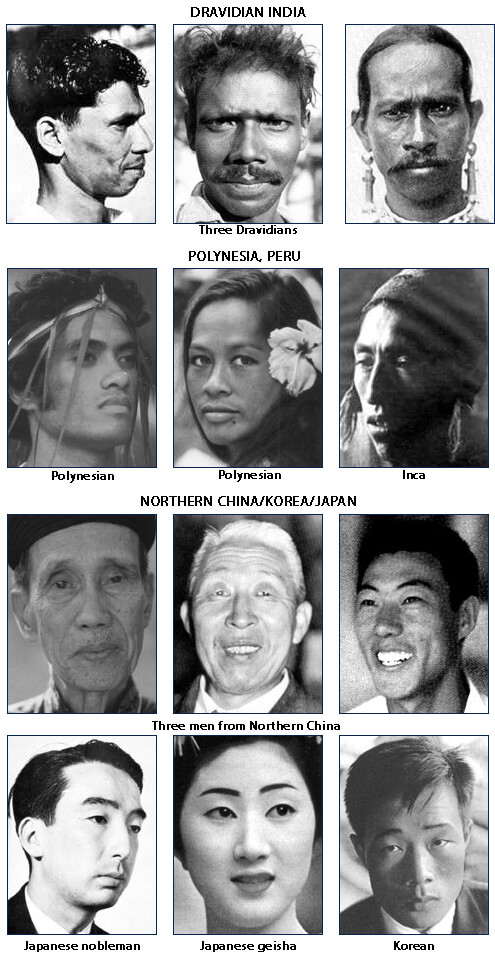
SOUTH PACIFIC: From Japan, 132 Andites embarked in a fleet of small boats and crossed the Pacific, tarrying on the many islands they found along the way. The Polynesian islands were larger and more numerous then, and as these Andite sailors passed through they added some desirable traits to the native stock. Many flourishing centers of civilization—Easter Island is one of them—grew up on these now submerged lands as a result of Andite penetration. Eventually these Andite seafarers reached South America, and by intermarriage with the natives of the Andes established the ancestry of the later rulers of the Incas. Of all the Andites who sailed the Pacific in those days, only this group ever reached the mainland.
By 8000 BC many groups of Andites had penetrated to the ends of the earth as missionaries, teachers, and traders. From Europe to China, the more highly civilized tribes began to assemble in cities devoted to manufacture and trade. Adonia, located near the present city of Ashkhabad, became the central Asian commercial metropolis.
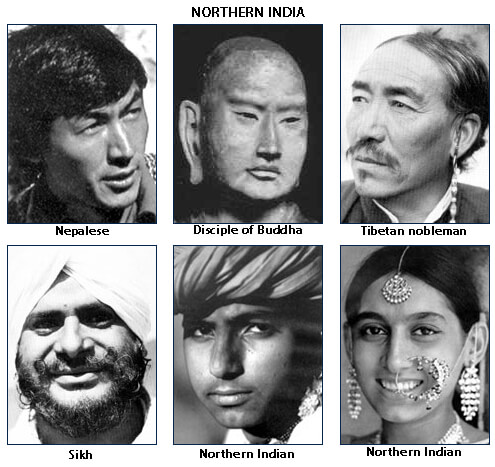
8000–2000 BC: THE LAST ANDITE MIGRATIONS
For almost twenty thousand years the Andonites had been pushed farther and farther to the north of central Asia, but by 8000 BC diminishing rainfall in Siberia had started to nudge them back down. Further, the slowly increasing aridity of the highland regions of central Asia began to drive the mixed Turkestan Andites to the river bottoms and the seashores, to the valleys of the Nile, Euphrates, Indus, and Yellow rivers. A new class of men—the traders—appeared. The tide of migration veered from northward to southward, and as the cavalrymen from the north began to infiltrate Mesopotamia, the purer, more civilized Andites were forced to disband.
Ten percent turned to the east and entered Sinkiang, where they blended with the Andite-yellow inhabitants. The offspring of this union later contributed to the immediate improvement of the northern Chinese peoples.
Ten percent, including a large group of the Sethite priests, moved eastward through the Elamite highlands to the Iranian plateau and Turkestan. Their descendants later teamed up with their Aryan brothers to invade India.
Ten percent made their way to Egypt via Arabia, where the remnant of the blue race had amalgamated with certain others, particularly the yellow. As the Andites passed through they upstepped this blend, which has persisted as the swarthy modern Arabs. During this time civilization in Egypt was thriving—there were seven distinct groups, all of whom, save one, came from Mesopotamia. The more adventurous Andites poured westward—some to Cyprus, others to what was later known as Carthage.
Five percent, representing the purest Andite strains, refused to leave their homeland near the mouths of the Tigris and Euphrates. This group, the Sumerians, had kept themselves free from intermarriage with the neighboring tribes. By 5000 BC, when heavy floods in Mesopotamia completed the disruption of Andite civilization, only in the south among these Sumerians did any trace of the former glory remain.
Sixty-five percent of the remaining Mesopotamian Andites entered Europe by the Caspian Sea route to conquer and amalgamate with the newly appearing white races, a blend of the blue man with the earlier Andites. All previous waves of Andites had moved so slowly that they tended to disintegrate at any great distance from Mesopotamia, but these later waves on horseback moved so rapidly that they reached Europe as coherent groups, still retaining some measure of higher culture. As they moved westward across the Russian plains, absorbing the best of the blue man and exterminating the worst, they became blended into one people. These were the ancestors of the so-called Nordic races, the forefathers of the Scandinavian, German, and Anglo-Saxon peoples. This blue/Andite race also contained a considerable amount of Andonite blood, together with smaller amounts of the red and yellow Sangik. The typical early Nordic was long-headed, tall, and blond.
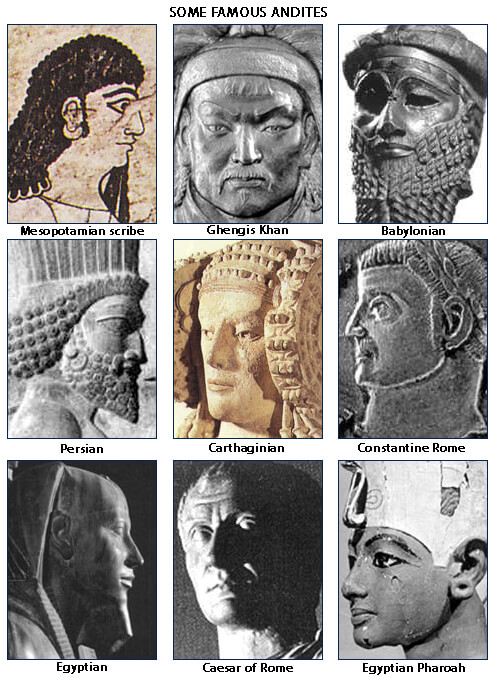
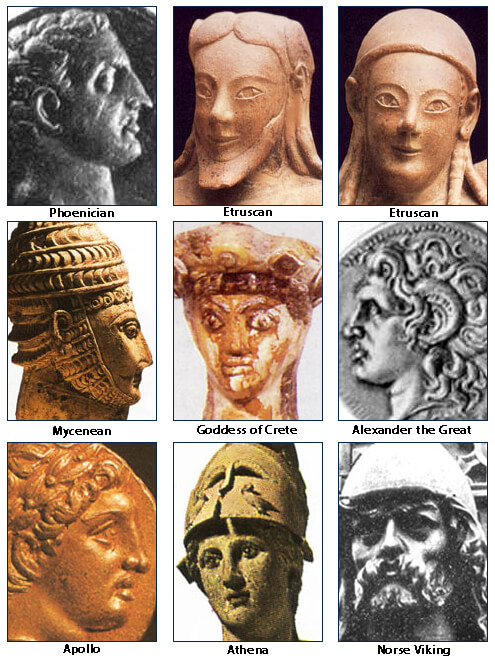
For three thousand years the military headquarters of the northern Andites was in Denmark. From this central point there went forth the successive invasions of Europe, which grew decreasingly Andite and increasingly white as the passing centuries witnessed the final blending of the conquerors with the conquered peoples. The Nordic aggressors met their biggest challenge from the Cro-Magnons in southern France, where the older race successfully defended their territories for five hundred years before succumbing to the white invaders. The Cro-Magnoid blue man constituted the biologic foundation for the modern European races, but he has survived only as absorbed by his white conquerors. By 5000 BC the evolving white races were dominant throughout all of northern Europe, including northern Germany, northern France, and the British Isles.
By 3000 BC the southward-moving nomadic Andonites from the north had reached the Caspian/Black Sea region, where they split to invade both Europe and Turkestan. This push lasted for a thousand years and dispossessed the remaining Turkestan Andites from their homeland.
EUROPE/INDIA: The residue of Adamson's descendants migrated north and west to enter Europe with the blended stock of the last Andite wave coming out of Mesopotamia, and they were also numbered among the Andite-Aryan invaders of India, which was the second Andite penetration of India. [While the Urantia Book refers only to those Andites invading India as Aryans, this is the same Andite stock that simultaneously invaded Europe.] The early Aryans were scattered over the northwestern half of India; those going south were soon absorbed by the Dravidians, who subsequently overran the entire peninsula except the Himalayan provinces. The greater persistence of the so-called Aryan blood in northern India is not only due to their presence in these regions in greater numbers but also because they were reinforced by later conquerors, traders, and missionaries. Aryan and Dravidian cultures eventually mingled on the plains of the Ganges to produce a high culture, and this center was later bolstered by contributions from China.
MESOPOTAMIA: The groups of commingled invaders from the north that continued to press south into Mesopotamia carried in their ranks many of the better Andite strains of the mixed northern races of Turkestan, including some of the Adamson stock. These barbarians quickly assimilated the residue of the civilization of Mesopotamia and presently developed into those mixed peoples found in the Euphrates valley at the dawn of recorded history. They did not immediately conquer the Sumerians, who were determined to maintain their racial and cultural superiority, but by 1790 BC, during the rule of Hammurabi, the Sumerians had become absorbed into the ranks of the northern Semites and the Mesopotamian Andites were no more.
MEDITERRANEAN: The disruption of land traffic during the great nomadic invasions brought about a big increase in Mediterranean sea commerce, resulting in the sudden expansion of the descendants of the Andites throughout the entire coastal territory of the Mediterranean basin. The brunet Mediterranean race, the most highly mixed of all, combined the blue man with a smaller Andonite strain than in the north, a considerable amount of secondary Sangik blood, strong Andite elements from the eastern Mediterranean and later, admixture from the blue-yellow-Andite peoples of Arabia. In the south the blue man has survived in greater numbers; the Basques of France and the Berbers of northern Africa, though thoroughly blended with the Saharans, represent two branches of this race.
It was not long before Egypt was overrun, as Mesopotamia had been, by inhospitable tribes from Arabia and from the south. Soon internal warfare along the Nile brought Egypt´s brilliant epoch of culture to an end. Large numbers of fleeing Andites entered Spain from northern Africa and later mingled in Switzerland with their brethren who had earlier come to Italy from the Aegean Islands. Many of the more able families fled to Crete, thus greatly augmenting this already advanced civilization. And when the arrival of unprogressive groups from Egypt later threatened the civilization of Crete, the more cultured families moved on west to Greece.
Presently Greece and the Aegean Islands region succeeded Mesopotamia and Egypt as the Occidental center of trade, art, and culture. Practically all of the art and science of the Aegean world was derived from Mesopotamia and the culture of the Adamsonites, but this high civilization soon regressed under the rapidly multiplying genetically mediocre descendants of the later-imported Danubian slaves. Many of the mixed descendants of these Adamsonites became incorporated in the tribes of the adjacent mainlands, and many of the advances in early Greek civilization persisted in the later peoples of southern Europe.
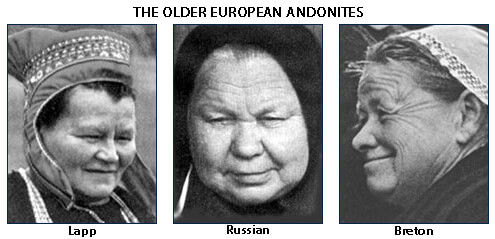
The older European Andonites retained a semblance of identity only in Lapland and to some extent, in Brittany; the Bretons never mingled with the Nordics, being survivors of the original Andonite inhabitants of western Europe, mixed with the Mediterranean stock. Other broad-headed survivors of the earlier European Andonites—often reinforced by arrivals of Andonites from Asia Minor—were dispersed through most of the mountainous regions of central and southeastern Europe. By 2500 BC the westward thrust of the Andonites from Siberia reached Europe, penetrating by way of both the Balkans and the Ukraine. This invasion carried with it the remaining groups of Adamson's descendants and considerable numbers of the Iranian Andites as well as many of the descendants of the Sethite priests. They moved slowly northward by way of the Danube valley, their most northerly settlement being at Liege in Belgium.
These Danubian Andonites later amalgamated with groups of Andonite sailors who came by boats from the coast of Asia Minor. Much of central Europe was thus early settled by these mixed types of swarthy, stocky, broad-headed white races, predominantly Andonite but containing strains of blue and yellow. These invaders have given the central white races a characteristically Alpine appearance; they are sandwiched between the Nordic and Mediterranean races, extending from eastern France to central Asia. The Nordic-Danish and the Danubian-Andonite cultures met and mingled on the Rhine as is witnessed by the existence of two racial groups in Germany today.
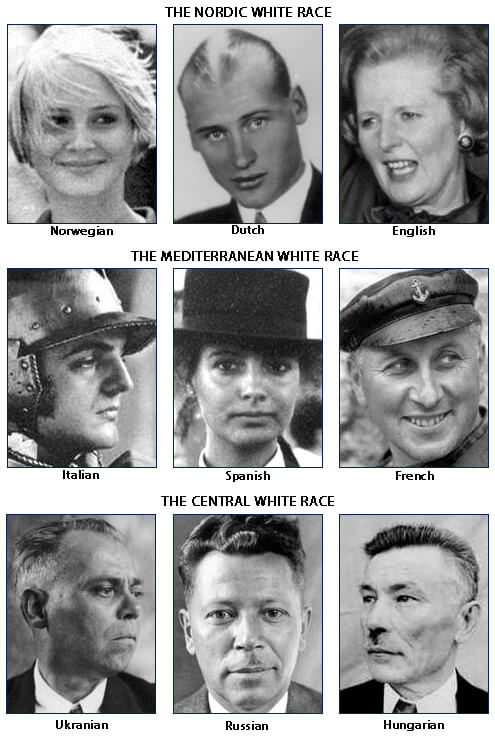
The races of today have resulted from various combinations of the five basic human stocks of Urantia, each identified by certain distinguishing physical characteristics. There were long-headed Adamites and Nodites, broad-headed Andonites, broad-headed yellow and blue men, and medium- to long-headed secondary Sangiks. While skull dimensions can help to decipher racial origins, the skeleton as a whole is far more dependable. Originally there were five distinct types of skeletal structure:
1. Andonic—Urantia aborigines.
2. Primary Sangik—red, yellow, and blue peoples.
3. Secondary Sangik—orange, green, and indigo peoples.
4. Nodite—descendants of the Dalamatians.
5. Adamic—the violet race.
Extensive intermingling of these five racial groups tended to obscure the Andonite type by Sangik hereditary dominance. The skeletons of the Andonite/blue Lapps and Eskimos come the nearest to preserving the aboriginal Andonic type. But the Adamites and the Nodites, so admixed with the other races, can now be detected only as a generalized Caucasoid order. While there still remain pockets of the original pure-line indigo, red, yellow and Andonic races, for the most part the racial distinctions have been blurred. Study of the skeletal structures unearthed from over the last 20,000 years will disclose that mankind is now divided into approximately three classes:
1. The Caucasoid—the Andite (Nodite plus Adamite) blend, modified by mostly primary Sangik admixture with considerable Andonic crossing. Included in this group are the Occidental white races as well as some Indian and Turanian peoples. Andite inheritance is the unifying factor.
2. The Mongoloid—the primary Sangik (original red/yellow/blue) type. The Chinese and Amerinds belong to this group. In Europe the Mongoloid (blue) type has been obscured by secondary Sangik, Andonic, and Andite infusion. Malayans and other Indonesian peoples, while they contain a high percentage of secondary Sangik blood, are included in this classification.
3. The Negroid—the secondary Sangik (original orange/green/indigo) type, best illustrated by the Negro, and found through Africa, India, and Indonesia wherever the secondary Sangik races located.
Caucasoid and Mongoloid types have blended somewhat in Northern China; Caucasoid and Negroid in the Levant; all three types are represented in India and South America. And the skeletal characteristics of the three surviving types still persist and help to identify the later ancestry of present-day human races.
These racial mixes have come about through the rise and fall of civilizations, overpopulation, food shortages, war, ice, floods, droughts, earthquakes and other planetary disruptions that forced the human race to stay on the move. Whole ethnic groups have thus been driven into the arms of other ethnic groups, insuring that the mating and blending game will continue until people stop being attracted to each other. Whether downstepping or upstepping, each group brought along his culture, his religion, his food, and his art with which to enrich the other. This is the history of our planet—past, present, and future.
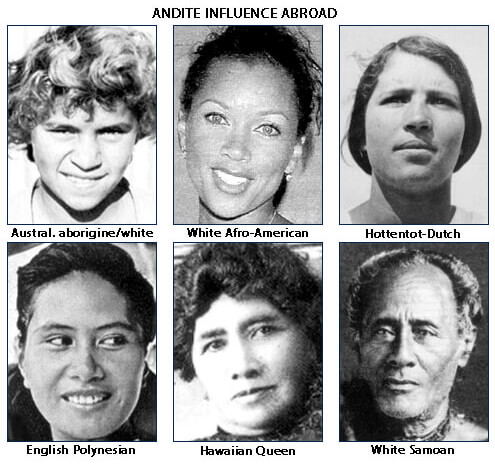
THE FUTURE
On a normal world the post-Adamic epoch sees the races practically blended, so that it can be truly proclaimed that "God has made of one blood all the nations," and "has made of one color all peoples." Our planet is still in a relatively primitive state and, we are told, lags far behind the average planetary schedule. But fear not! We are not out of the running! If we are to find wise solutions to our problems we must first learn to identify them, by objectively facing our planetary history and studying it, side by side, together with a blueprint of God's evolutionary plan. And on that distant day when Urantia is in step with the more advanced spheres—when we are all of one color, with a language in common and one representative world government—we will look back on today's struggles and challenges as soul- and spirit-building stepping stones that inched us ever closer to the God of all creation.
Disclaimer: All interpretations of the physical characteristics of the racial types mentioned in the Urantia Book are my own. The images in this article represent my personal collection gathered over the past forty years from many sources, including my family photo album - Saskia Praamsma.

